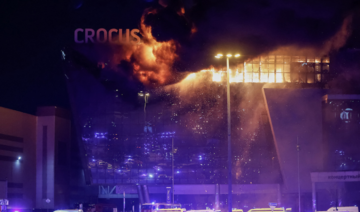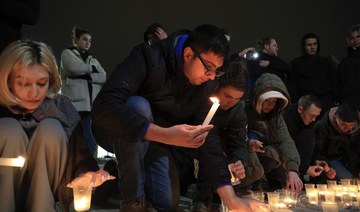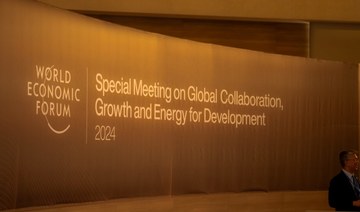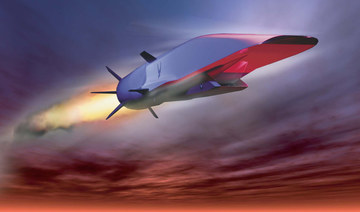MOSCOW: Russian authorities arrested the four people suspected of taking part in the attack on a suburban Moscow concert hall that killed at least 133 people and believe they were headed to Ukraine, President Vladimir Putin said Saturday during an address to the nation.
Kyiv, meanwhile, strongly denied any involvement in Friday’s attack on the Crocus City Hall music venue in Krasnogorsk, which the Daesh group’s affiliate in Afghanistan claimed responsibility for in a statement posted on social media channels linked to the group. Kyiv accused Putin and other Russian politicians of falsely linking Ukraine to the assault in order to stoke fervor in Russia’s war in Ukraine, which recently entered its third year.
A US intelligence official told The Associated Press that US agencies had confirmed that IS was responsible for the attack.
Putin said authorities have detained a total of 11 people in the attack, which also injured scores of concertgoers and left the venue a smoldering ruin. He called it “a bloody, barbaric terrorist act” and said Russian authorities captured the four suspected gunmen as they were trying to escape to Ukraine through a “window” prepared for them on the Ukrainian side of the border.
Putin also said that additional security measures have been imposed throughout Russia, and he declared Sunday to be a day of mourning.
Investigators on Saturday were combing through the charred wreckage of the hall for more victims, and the authorities said the death toll could still rise. Hundreds of people stood in line in Moscow early Saturday to donate blood and plasma, Russia’s health ministry said.
“We faced not just a thoroughly and cynically prepared terror attack, but a well-prepared and organized mass murder of peaceful innocent people,” Putin said.
The attack, which was the deadliest in Russia in years, came just days after Putin cemented his grip on power in a highly orchestrated electoral landslide and as the war in Ukraine drags on.
Some Russian lawmakers pointed the finger at Ukraine immediately after the attack. But Mykhailo Podolyak, an adviser to Ukrainian President Volodymyr Zelensky, denied any involvement.
“Ukraine has never resorted to the use of terrorist methods,” he posted on X. “Everything in this war will be decided only on the battlefield.”
Ukraine’s foreign ministry accused Moscow of using the attack to try to stoke fervor for its war efforts.
“We consider such accusations to be a planned provocation by the Kremlin to further fuel anti-Ukrainian hysteria in Russian society, create conditions for increased mobilization of Russian citizens to participate in the criminal aggression against our country and discredit Ukraine in the eyes of the international community,” the ministry said in a statement.
Images shared by Russian state media Saturday showed a fleet of emergency vehicles still gathered outside the ruins of Crocus City Hall, which could hold more than 6,000 people and has hosted many big events, including the 2013 Miss Universe beauty pageant that featured Donald Trump and other VIPs.
Videos posted online showed gunmen in the venue shooting civilians at point-blank range. Russian news reports cited authorities and witnesses as saying the attackers threw explosive devices that started the fire. The roof of the theater, where crowds had gathered for a performance by the Russian rock band Picnic, collapsed early Saturday as firefighters spent hours fighting the blaze.
In a statement posted by its Aamaq news agency, the IS’s Afghanistan affiliate said it had attacked a large gathering of “Christians” in Krasnogorsk.
A US intelligence official told the AP that American intelligence agencies had gathered information in recent weeks that the IS branch was planning an attack in Moscow, and that US officials had privately shared the intelligence earlier this month with Russian officials.
The official was briefed on the matter but was not authorized to publicly discuss the intelligence information and spoke to the AP on condition of anonymity.
Messages of outrage, shock and support for the victims and their families have streamed in from around the world.
On Friday, the UN Security Council condemned “the heinous and cowardly terrorist attack” and underlined the need for the perpetrators to be held accountable. UN Secretary-General Antonio Guterres also condemned the terrorist attack “in the strongest possible terms,” his spokesman said.
Putin, who extended his grip on Russia for another six years in this week’s presidential vote after a sweeping crackdown on dissent, had publicly denounced the Western warnings of a potential terrorist attack as an attempt to intimidate Russians. “All that resembles open blackmail and an attempt to frighten and destabilize our society,” he said earlier this week.
In October 2015, a bomb planted by IS downed a Russian passenger plane over Sinai, killing all 224 people on board, most of them Russian vacation-goers returning from Egypt. The group, which operates mainly in Syria and Iraq but also in Afghanistan and Africa, also has claimed several attacks in Russia’s volatile Caucasus and other regions in the past years. It recruited fighters from Russia and other parts of the former Soviet Union.
Putin says gunmen in Moscow attack tried to escape to Ukraine, Kyiv denies involvement
https://arab.news/gqzkk
Putin says gunmen in Moscow attack tried to escape to Ukraine, Kyiv denies involvement
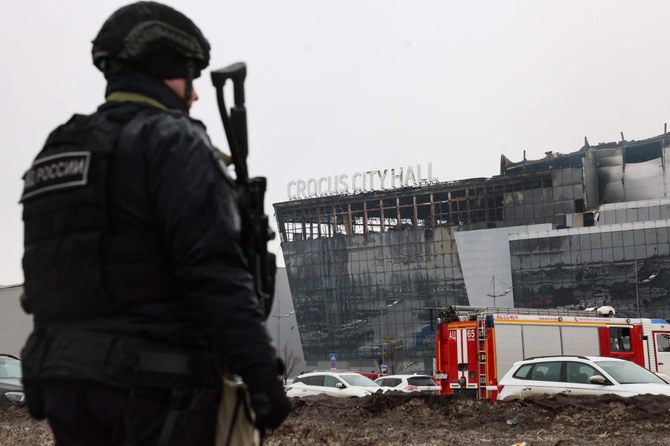
- Daesh claimed responsibility for the attack, deadliest in Russia since Beslan school siege in 2004
- Authorities detain total of 11 people after the attack, which killed 133
French police ‘neutralized’ armed person who tried to set fire to synagogue in Rouen — Darmanin
- The incident occurred early on Friday morning
The incident occurred early on Friday morning, Darmanin said in a post on social network X.
Regional French broadcaster France 3 said fire fighters were on the site.
Rouen mayor said in a post the Normandy town was ‘battered and shocked’.
Against the backdrop of tensions in Middle East and Israel’s ground offensive in the Gaza strip, France recently raised its alert level to the highest level.
Suspected gunshots near Israeli embassy in Stockholm prompt police cordon
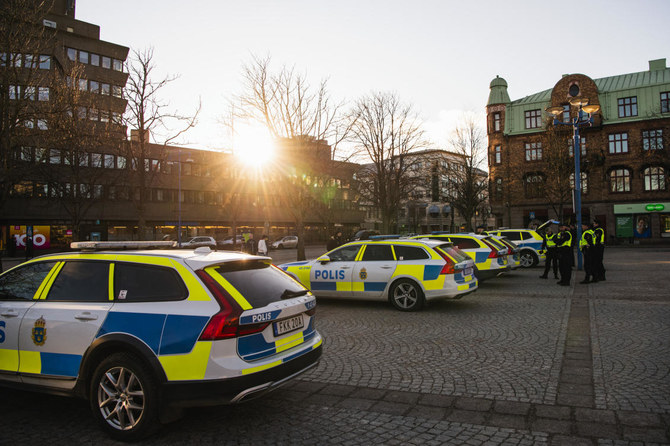
STOCKHOLM: Swedish police have detained several people and cordoned off an area in Stockholm after a patrol heard suspected gunshots, they said on Friday, with the Israeli embassy located in the closed-off area.
"A police patrol at Strandvagen in Stockholm heard bangs and suspected there had been a shooting," police said on their website, adding that the affected area lay between the capital's Djurgarden Bridge, its Nobel Park and the Oscar Church.
Several people have been detained and an investigation has been launched into a suspected serious weapons crime, they added.
"In connection with the ongoing forensic investigation, findings have been made that strengthen the suspicions that a shooting took place," police said on its website.
Reuters could not immediately reach police and the Israeli embassy for comment.
Swedish news agency TT said police declined to comment on whether there was a link between the incident and the Israeli embassy.
‘Hindu nation’: Religion trumps caste in India vote

- Modi’s strategy of appealing to pan-Hindu unity has reaped political dividends
- Modi government accused of marginalizing country’s 200-million-plus Muslims
AGRA, India: Born at the bottom of the Hindu faith’s rigid caste system, voters like Anil Sonkar will determine whether Indian Prime Minister Narendra Modi returns to power next month.
More than two-thirds of India’s 1.4 billion people are estimated to be on the lower rungs of a millennia-old social hierarchy that divides Hindus by function and social standing.
Politicians of all stripes have courted lower caste Indians with affirmative action programs, job guarantees and special subsidies to mitigate long-standing discrimination and disadvantage.
But Modi’s Hindu-nationalist Bharatiya Janata Party (BJP) has established itself as India’s dominant political force with a different pitch: think of your religion first, and caste second.
“There are no economic opportunities and business has never been so bad for me,” said Sonkar, a 55-year-old fishmonger and a member of the Dalit castes, once disparagingly known as “untouchables.”
“But under this government, we feel safe and proud as Hindus,” he told AFP in the tourist city of Agra, home of the Taj Mahal. “That is why, despite everything, I voted for Modi.”
Modi’s party is expected to easily win this year’s national election once it concludes in June, in large part due to his government’s positioning of the Hindu faith at the center of its politics.
His government has been accused in turn of marginalizing the country’s 200-million-plus Muslims, leaving many among them fearful for their futures in India.
But its strategy of appealing to pan-Hindu unity, and directing the faith’s internal frictions outwards, has reaped political dividends.
“The BJP’s base among the marginalized has grown over every election since 2014,” political scientist and author Sudha Pai told AFP.
The party, she added, had successfully forged a new pan-Hindu political coalition by showing respect to the “cultural symbols, icons and history” of low-caste voters, and in the process furthering its goal of building a “Hindu nation.”
Caste remains a crucial determinant of one’s station in life at birth, with higher castes the beneficiaries of ingrained cultural privileges, lower castes suffering entrenched discrimination, and a rigid divide between both.
Modi himself belongs to a low caste, but the elite worlds of politics, business and culture are largely dominated by high-caste Indians.
Less than six percent of Indians married outside their caste, according to the country’s most recent census in 2011.
Modi’s political coalition has managed to bridge this internal divide by trumpeting a vision of a resurgent and assertive Hindu faith.
The prime minister began the year by inaugurating a grand temple to the Hindu deity Ram, built on the site of a centuries-old mosque razed by Hindu zealots decades earlier.
Construction of the temple fulfilled a long-standing demand of Hindu activists and was widely celebrated by Hindu voters, whatever their caste group.
Modi’s rise also coincided with the declining fortunes of caste-based political parties that had dominated politics for decades in Uttar Pradesh, India’s most populous state with more people than Nigeria and its most important electoral battleground.
Many in the state accused these parties of directing welfare programs and other benefits of political power to their own caste groups, a situation they say changed when Modi came to power and made them available for all disadvantaged voters.
“The soles of my slippers wore off as I ran around trying to get a card for free rations,” homemaker Munni Devi, 62, told AFP at a BJP campaign rally over the din of frenzied drum beats and music.
“But Modi gave me one immediately after coming to power,” she told AFP.
The BJP has been able to unite a broad array of caste groups into a single bloc of support, but caste discrimination remains a fact of life both in politics and society at large.
Despite Modi’s own low-caste origins, the senior ranks of his ministry, party and civil service remain overwhelmingly dominated by upper-caste functionaries.
“Our lawmaker is from our caste and from the BJP,” said farmer Patiram Kushwaha, a Modi supporter reconsidering his allegiance.
“He cannot do anything for us because those sitting at the top don’t listen to him.”
More than two dozen opposition parties in this year’s poll have campaigned on a joint pledge to address the structural causes of discrimination by staging a caste-based national census and redirecting resources to the most disadvantaged.
Analysts nonetheless expect Modi to triumph convincingly over the opposition bloc, but Neelanjan Sircar, of the Center for Policy Research think-tank in New Delhi, said the BJP faced a monumental challenge in holding its coalition together over the long term.
“This balancing act of keeping together groups which don’t really get along with each other is extremely tough in the long run,” he told AFP. “At some point, you have to face the demons of those contradictions.”
UN reports improved prospects for the world economy and forecasts 2.7 percent growth in 2024

- The mid-2024 report says the world economy is now projected to grow by 2.7 percent this year and by 2.8 percent in 2025
UNITED NATIONS: The United Nations reported improved prospects for the world economy since its January forecast on Thursday, pointing to a better outlook in the United States and several large emerging economies including Brazil, India and Russia.
According to its mid-2024 report, the world economy is now projected to grow by 2.7 percent this year – up from the 2.4 percent forecast in its January report – and by 2.8 percent in 2025. A 2.7 percent growth rate would equal growth in 2023, but still be lower than the 3 percent growth rate before the COVID-19 pandemic began in 2020.
“Our prognosis is one of guarded optimism, but with important caveats,” Shantanu Mukherjee, director of the UN’s Economic Analysis and Policy Division, told a news conference launching the report.
The report pointed to interest rates that are higher for longer periods, debt repayment challenges, continuing geopolitical tensions and climate risks especially for the world’s poorest countries and small island nations.
Mukherjee said inflation, which is down from its 2023 peak, is both “a symptom of the underlying fragility” of the global economy where it still lurks, “but also a cause for concern in its own right.”
“We’ve seen that in some countries inflation continues to be high,” he said. “Globally, energy and food prices are inching upward in recent months, but I think a bit more insidious even is the persistence of inflation above the 2 percent central bank target in many developed countries.”

The UN forecast for 2024 is lower than those of both the International Monetary Fund and the Organization for Economic Cooperation and Development.
In mid-April, the IMF forecast that the world economy would continue growing at 3.2 percent during 2024 and 2025, the same pace as in 2023. And the OECD in early May forecast 3.1 percent growth in 2024 and 3.2 percent in 2025.,
The latest UN estimates foresee 2.3 percent growth in the United States in 2024, up from 1.4 percent forecast at the start of the year, and a small increase for China from 4.7 percent in January to 4.8 percent. for the year.
Despite climate risks, the report by the UN Department of Economic and Social Affairs forecasts improved economic growth from 2.4 percent in 2023 to 3.3 percent in 2024 for the small developing island nations primary due to a rebound in tourism.
On a negative note, the report projects that economic growth in Africa will be 3.3 percent, down from 3.5 percent forecast at the beginning of 2024. It cited weak prospects in the continent’s largest economies – Egypt, Nigeria and South Africa – along with seven African countries “in debt distress” and 13 others at “high risk of debt distress.”
Mukherjee said the lower forecast for Africa “is particularly worrying because Africa is home to about 430 million (people) living in extreme poverty and close to 40 percent share of the global undernourished population” and “two-thirds of the high inflation countries listed in our update are also in Africa.”
For developing countries, he said, the situation isn’t “as dire” but an important concern is the continuing fall and sharp decline in investment growth.
Japan, US move ahead in co-developing hypersonic weapons interceptor as regional threats grow

TOKYO: Japan and the United States on Wednesday signed an arrangement to jointly develop a new type of missile defense system as the allies seek to defend against the growing threat of hypersonic weapons, which are possessed by China and Russia and being tested by North Korea.
The project was initially agreed between Japan’s Prime Minister Fumio Kishida and US President Joe Biden at their summit last August and reaffirmed between the leaders during Kishida’s April visit to Washington. The Glide Phase Interceptor is planned for deployment by the mid-2030s.
Wednesday’s agreement determines the allocation of responsibility and decision-making process, a first major step in the project, Japanese defense ministry officials said. They hope to decide on Japanese contractors and start the development process by March 2025.
Hypersonic weapons are designed to exceed Mach 5, or five times the speed of sound, posing a threat to regional missile-defense systems with their speed and maneuverability. Developing interceptors of them is a challenge.

Japan’s defense ministry called it a “pressing issue” and noted that hypersonic weapons in the region have dramatically improved in recent years.
Under the arrangement, Japan is responsible for developing a part at the interceptor’s tip that separates in space to destroy the incoming warhead, as well as its rocket motors, officials said.
Japan has earmarked 75.7 billion yen ($490 million) for initial development and testing of the interceptor, according to the defense ministry.
The cost includes making components for the two companies, Raytheon Technologies and Northrop Grumman, that are developing the weapon in a competition led by the US Missile Defense Agency. One will be chosen for the project.
The MDA has estimated the cost to develop the hypersonic missile interceptor will exceed $3 billion, including Japan’s share of $1 billion.
The interceptors will be deployed on Aegis-class destroyers, like the ship-to-air Standard Missile-3 that Japan previously co-developed with the United States.
Japan has been accelerating its miliary buildup as it stresses the need to fortify its deterrence against growing threats. Japan has also significantly eased its weapons export policy to allow co-developed lethal weapons to third countries.
___
This story has been corrected to say GPI stands for Glide Phase Interceptor, not Glide Sphere Interceptor.
___
Follow AP’s Asia-Pacific news at https://apnews.com/hub/asia-pacific



